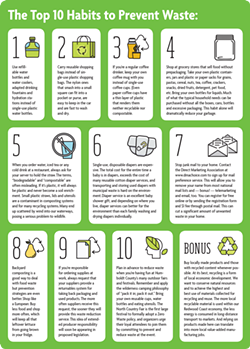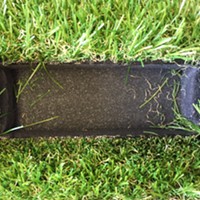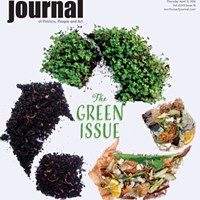[
{
"name": "Top Stories Video Pair",
"insertPoint": "7",
"component": "17087298",
"parentWrapperClass": "fdn-ads-inline-content-block",
"requiredCountToDisplay": "1"
}
]
Small changes in your daily habits can significantly reduce your carbon footprint. In fact, our purchasing habits can yield a greater benefit for the environment than our recycling and composting habits. Not creating waste in the first place means less energy wasted and fewer resources consumed. When you purchase products with less packaging, you bypass the consumption of energy and water needed for the manufacture, sales and distribution of wrappers and containers that are usually used once. So while all the Rs — refuse, reduce, reuse, recycle, rot, reuse, repurpose, etc. — are important, Zero Waste Humboldt emphasizes prevention, targeting single-use products and packaging. According to www.Earth911.org, reducing your garbage by just 10 percent cuts carbon dioxide emissions by 1,200 pounds. These waste prevention techniques are also the basic home economics of bygone days that help the environment and save you money.
1. Use refillable water bottles and water coolers, adapted drinking fountains and hydration stations instead of single-use plastic water bottles.2. Carry reusable shopping bags instead of single-use plastic shopping bags. The nylon ones that smash into a small square can fit into a pocket or purse, are easy to keep in the car and are fast to wash and dry.
3. If you're a regular coffee drinker, keep your own coffee mug with you instead of single-use coffee cups. (Even paper coffee cups have a thin layer of plastic that renders them neither recyclable nor compostable.
4. Shop at grocery stores that sell food without prepackaging. Take your own plastic containers, jars and plastic or paper sacks for grains, pastas, cereal, nuts, tea, coffee, crackers, snacks, dried fruits, detergent, pet food, etc. Bring your own bottles for liquids. Much of what the typical household needs can be purchased without all the boxes, cans, bottles and excessive packaging. This habit alone will dramatically reduce your garbage.
5. When you order water, iced tea or any cold drink at a restaurant, always say ask for your server to hold the straw. The terms, “biodegradable” and “compostable” are often misleading. If it’s plastic, it will always be plastic and never become a soil enrichment. Small plastic straws, lids and utensils are a contaminant in composting systems and for many recycling systems. Many end up scattered by wind into our waterways, posing a serious problem to wildlife.
6. Single-use, disposable diapers are expensive. The total cost of disposable diapers for the entire time a baby is in diapers, exceeds the cost of many reusable cotton diaper services, and transporting and storing used diapers with municipal waste is hard on the environment. Diaper service is an excellent baby shower gift, and depending on where you live, diaper services can better for the environment than each family washing and drying diapers individually.
7. Stop junk mail to your home. Contact the Direct Marketing Association at www.dmachoice.com to sign up for mail preference service. This will allow you to remove your name from most national mail lists and — bonus! — telemarketing and e-mail, too. You can register for free online or by sending the registration form and $1 fee through postal mail. This can cut a significant amount of unwanted waste in your home.
8. Backyard composting is a good way to deal with food waste but prevention strategies are even better. Shop like a European: Buy less food and shop more often, which will keep all that leftover lettuce from going brown in your fridge.
9. If you’re responsible for ordering supplies at work, always request that your suppliers provide a returnables system for taking back packaging and used products. The more often suppliers receive this request, the sooner they will provide this waste reduction service. This idea of extended producer responsibility will soon be appearing in proposed legislation.
10. Plan in advance to reduce waste when you’re having fun at Humboldt County’s many outdoor fairs and festivals. Remember and apply the wilderness camping philosophy of “pack it in; pack it out.” Bring your own reusable cups, water bottles and eating utensils. The North Country Fair is the first large festival to formally adopt a Zero Waste policy, and organizers urge their loyal attendees to join them by committing to prevent and reduce waste at the event.
BONUS:
11. Buy locally made products and those with recycled content whenever possible. At its best, recycling is a form of local economic development. We want to conserve natural resources and to achieve the highest and best use of materials collected for recycling and reuse. The more local recyclable material is used within our Redwood Coast economy, the less energy is consumed in long-distance transport to markets. And relying on products made here can translate into more local value-added manufacturing jobs.
For more information about how to achieve Zero Waste in your home, school, business and local government, email Zero Waste Humboldt at [email protected]
Latest in News
Readers also liked…
-
Through Mark Larson's Lens
A local photographer's favorite images of 2022 in Humboldt
- Jan 5, 2023
-
'To Celebrate Our Sovereignty'
Yurok Tribe to host gathering honoring 'ultimate river warrior' on the anniversary of the U.S. Supreme Court ruling that changed everything
- Jun 8, 2023


































